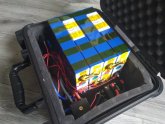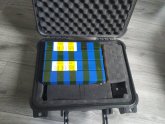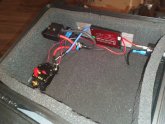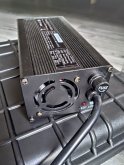Hi all,
Seeing as how I got the inspiration to make my own lithium based battery from the video`s by Will Prowse and the posts on this forum, I thought it only fair to post the build here.
I`ve been lugging heavy lead acid batteries around for a while when fishing, so I decided to look into Lithium, mainly 18650 cells. But quickly realised that they weren't particularly well suited for their intend use (too high a voltage or too low). And quite a hassle to assemble, not to mention the possibility to have them go up in rather spectacular flames. Then I stumbled into Will`s video`s on Lifepo4 cells. This chemistry/format seemed to solve all those issues so I figured it was finally time to have a go at it. Many weeks later I managed to get all the parts and tools and this is the result.
The list of parts:
- 90ah EVE cells *
- 60a Daly BMS **
- waterproof voltage indicator (touch activated)
- waterproof 12v car plug
- 50a anderson connector (3d printed flush mount & waterproofed the cables with grommets)
- 60a automatic fuse
- junction block for the negative end (3d printed)
- a pelican style box 35x29.5x15cm (tight fit, the cells don't seem to move)
- 18a 14.6v wall-charger for lifepo4 from aliexpress (Waouks) ***
* I used 90ah EVE cells, which were sourced from Xuba on alibaba. Which was a hassle-free experience, shipped straight to my house with all taxes paid. Extremely well packaged too btw. They're the exact same size as the 105ah`s, but the pricing was a lot better. I tested the cells and the capacity checks out, so thumbs up!
** The BMS is probably undersized. During a testrun the BMS overheated at anything above 30a (after 1hr or so). Granted, I had it encased in foam...now its glued to strips of aluminium and the foam has been removed. Will test this soon if this fixes the issue, might have to go with 80-100a BMS though.
*** Didn't see many recommendations for chargers so I just picked one that seemed to fit the bill and doesn't break the bank. These seem be sold locally as well, but rebranded and priced much much higher. So far its been performing nicely.
Hopefully this will help someone that's in the same boat as I was. And feel free to point out possible issues or improvements, since its my first build I'm sure i've overlooked many a thing.






Seeing as how I got the inspiration to make my own lithium based battery from the video`s by Will Prowse and the posts on this forum, I thought it only fair to post the build here.
I`ve been lugging heavy lead acid batteries around for a while when fishing, so I decided to look into Lithium, mainly 18650 cells. But quickly realised that they weren't particularly well suited for their intend use (too high a voltage or too low). And quite a hassle to assemble, not to mention the possibility to have them go up in rather spectacular flames. Then I stumbled into Will`s video`s on Lifepo4 cells. This chemistry/format seemed to solve all those issues so I figured it was finally time to have a go at it. Many weeks later I managed to get all the parts and tools and this is the result.
The list of parts:
- 90ah EVE cells *
- 60a Daly BMS **
- waterproof voltage indicator (touch activated)
- waterproof 12v car plug
- 50a anderson connector (3d printed flush mount & waterproofed the cables with grommets)
- 60a automatic fuse
- junction block for the negative end (3d printed)
- a pelican style box 35x29.5x15cm (tight fit, the cells don't seem to move)
- 18a 14.6v wall-charger for lifepo4 from aliexpress (Waouks) ***
* I used 90ah EVE cells, which were sourced from Xuba on alibaba. Which was a hassle-free experience, shipped straight to my house with all taxes paid. Extremely well packaged too btw. They're the exact same size as the 105ah`s, but the pricing was a lot better. I tested the cells and the capacity checks out, so thumbs up!
** The BMS is probably undersized. During a testrun the BMS overheated at anything above 30a (after 1hr or so). Granted, I had it encased in foam...now its glued to strips of aluminium and the foam has been removed. Will test this soon if this fixes the issue, might have to go with 80-100a BMS though.
*** Didn't see many recommendations for chargers so I just picked one that seemed to fit the bill and doesn't break the bank. These seem be sold locally as well, but rebranded and priced much much higher. So far its been performing nicely.
Hopefully this will help someone that's in the same boat as I was. And feel free to point out possible issues or improvements, since its my first build I'm sure i've overlooked many a thing.






Last edited:




